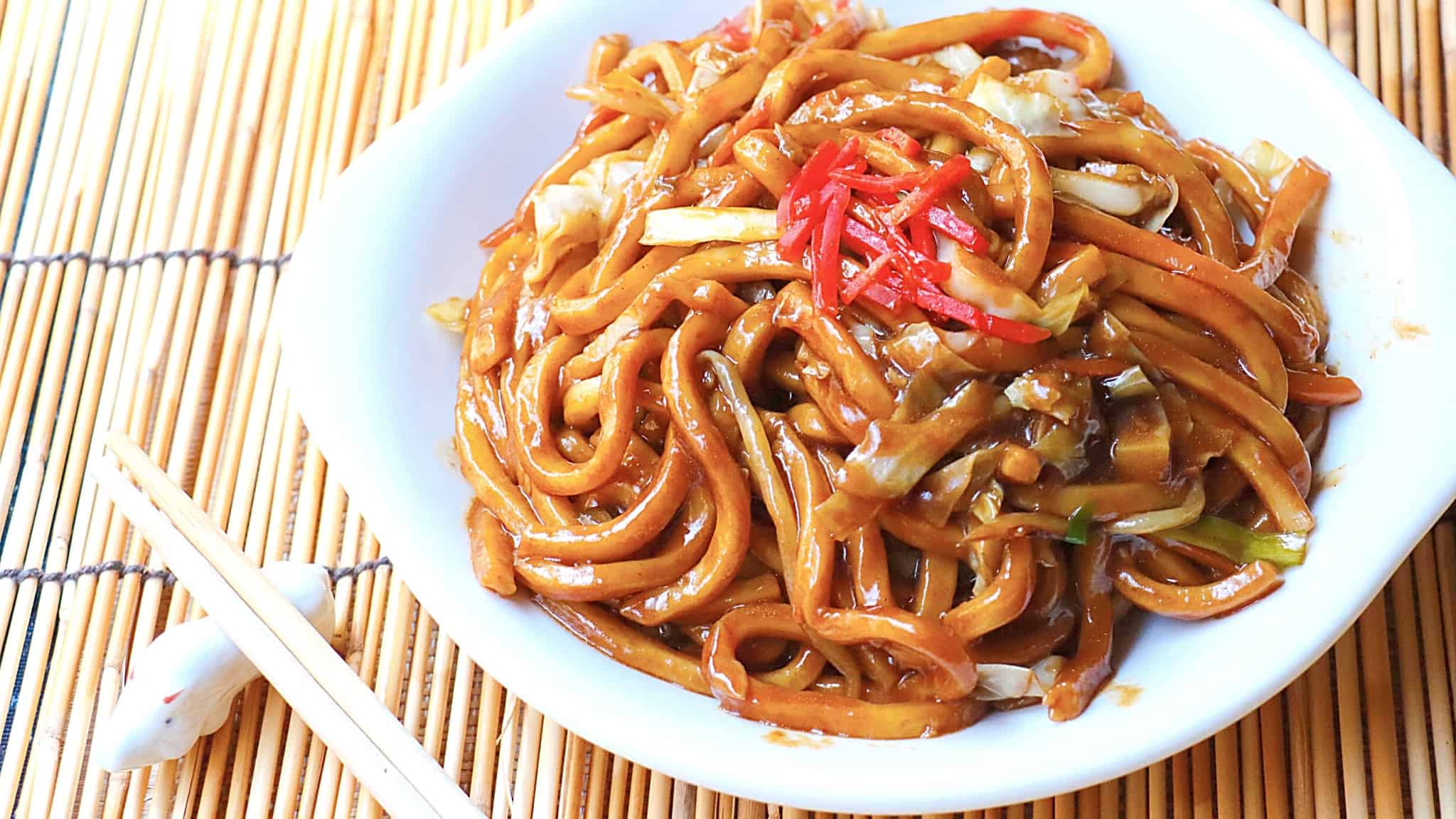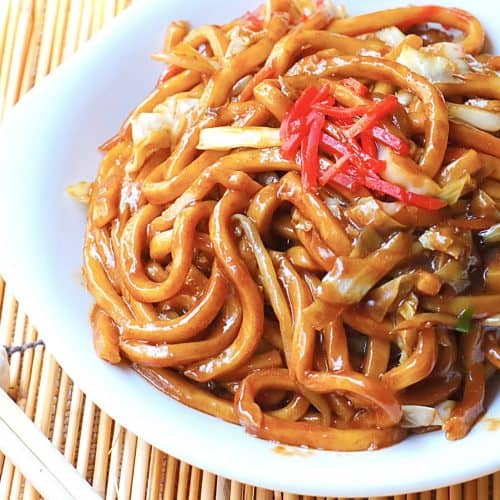Yaki udon recipe | How to make one of Japan’s favorite noodle dishes
Imagine a big bowl of stir-fried udon noodles in a delicious umami sauce with ground beef and mushrooms. It sounds tasty, right?
If you like easy-to-make Japanese meals with minimal ingredients, then yaki udon is a must-try!
It’s different from udon soup because the noodles are stir-fried together with meat and vegetables.

This recipe takes about 20 minutes to make, and you can use whatever type of meat and vegetables you have on hand. I’m going for a “bolognese” type of flavor and texture, so I chose ground beef and mushrooms as my main ingredients.
To make this genuinely Asian-inspired though, I’m adding some bok choy (Chinese cabbage), spring onions, mirin, and dark soy sauce.


Check out our new cookbook
Bitemybun's family recipes with complete meal planner and recipe guide.
Try it out for free with Kindle Unlimited:
Read for freeIn this post we'll cover:
Yaki udon with ground beef recipe
Ingredients
- 14 oz udon noodles 2 packs
- ½ lb ground beef
- 1.5 cups shiitake mushrooms sliced
- 1 carrot julienne cut long strips
- 4 small bok choy (or 2 large) quartered
- ½ white onion chopped
- 2 spring onions or scallions
- 1 tbsp vegetable oil
For the sauce:
- 3 tbsp soy sauce preferably dark
- 1 tbsp mirin
- 2 tbsp oyster sauce
- ½ tsp rice vinegar
- 2 tsp brown sugar or 1 tsp maple syrup
Instructions
- In a pot, add water and bring to a boil. Add the udon noodles and cook according to packaging instructions. Frozen udon noodles are pre-cooked and only require a couple of minutes of boiling.
- Chop all the vegetables and set them aside.
- To make the sauce, grab a bowl and mix the soy sauce, mirin, oyster sauce, rice vinegar, and sugar.
- Rinse the noodles under cold water to separate them and then drain.
- In a large wok or saucepan, heat up the oil.
- Add the ground beef and cook for 2 minutes, constantly stirring and mixing the meat to avoid clumps.
- Add the onion, carrots, mushrooms, and bok choy to the pan and stir-fry for another 2 minutes.
- Now add the noodles and drizzle on the sauce. Keep stir-frying for 3-4 minutes.
- The dish is ready to serve! Garnish with chopped spring onion.
Notes
Check out YouTube user Joshua Weissman’s video on making yaki udon:
Why use frozen udon noodles?
You can use dry udon noodles, but they must cook for longer.
A disadvantage is that dry udon noodles never get as thick and chewy as frozen udon noodles, so you might not get that ideal texture you’re looking for.
I prefer frozen or vacuum-sealed noodles because they’re easy to use. Also, they’re pre-cooked and only need about a minute or 2 of boiling.
And finally, these noodles are chewier and more slippery because they retain their shape. Frozen noodles are less likely to go all mushy and get overcooked.
After you drain the noodles, you may find that they’re very sticky and clumpy. In that case, you can add a tsp of cooking oil and mix it with your hands or tongs to unstick them.
Cooking tips
Needless to say, making this dish is one of the easiest recipes I’ve tried so far. However, there are actually a few cooking tips that’d make your chicken yaki udon irresistible!
Check out some of my cooking tips here and be sure to take note of them:
- The secret to making the most delicious stir-fried yaki udon noodles is to evenly distribute heat in your cooking, making your noodles chewy and delectable. In that case, I’d highly suggest you use a wok, especially if you’ll be making this dish more often.
- The best udon noodles are frozen noodles. So quickly take out your udon noodles from the freezer, and put them into the boiling water.
- Instead of constantly stir-frying the vegetables, cover the frying pan and steam them. Make sure to turn the stove’s heat down to a low setting. All of the large vegetables will quickly steam and become tender because of the moisture in them.
- Prepare all the ingredients in advance, as cooking these noodles only takes a few minutes. If you haven’t prepared them yet, you could get into trouble! Don’t forget to include your very own udon stir-fry sauce as well.
Substitutes and variations
But wait, are you missing out on an important ingredient? Check out these awesome substitutes and variations for our mouth-watering yaki udon!
Using dried udon noodles instead of fresh udon noodles
If you don’t have fresh and frozen udon noodles, you can still use dried udon noodles, but the shape will be somewhat flatter than that of fresh udon and fatter. However, the quality of dried udon noodles cooked in boiling water like spaghetti is a bit undesirable.
Using soba noodles instead of udon noodles
Japanese soba noodles can frequently be substituted for udon because of soba’s similar springiness and slickness. Even though the texture won’t be quite the same, soba stands up well in both hot and cold soups.
Making it vegan
Yaki udon is extremely versatile.
The base of the dish is the noodles, and then soy sauce and mirin. Other than that, you’re free to use whatever type of protein you like, and the vegetables of your choice too!
To make vegan yaki udon, I recommend replacing the meat with stir-fried tofu, which pairs well with the umami sauce. Of course, you can just have the noodles with extra vegetables.
Here are some other great options:
- Broccoli
- Spinach
- Carrots
- Mushrooms
- Bok choy
- Cabbage
- Snap peas
- Zucchini
- Bamboo shoots
Instead of oyster sauce, you can use vegan hoisin sauce.
If you’re out of oyster sauce, but you’re not vegan, you can use any type of fish sauce or sweet soy sauce.
Also read: 12 best soy sauce substitutes you might already have
Some people also like to add about 2 tsp of dashi to the sauce to give it a bit of a seafood-like flavor. However, this is optional, and I find that mirin and soy sauce is enough since the beef is quite flavorful.
How to serve and eat
Warm, chewy noodles taste best, and that’s why yaki udon is best served hot and straight from the pan. The noodles are placed in bowls and enjoyed with a cold drink (like beer or cold sake).
In Japan, it’s custom to eat yaki udon noodles with chopsticks. You slurp up the noodles and take small bites of the meat and vegetables.
Nobody will judge you for slurping the noodles up when you eat udon because they’re thick and saucy!
Since yaki udon isn’t a soup, it’s considered to be a complete main dish.
The stir-fry combines protein, noodles, a savory sauce, and crunchy vegetables. So it’s got everything you need for a satisfying lunch or dinner!
Similar dishes
Can’t get enough of our yaki udon recipe? Then check out similar dishes to add to your list.
Yakisoba
A traditional Japanese stir-fried noodle dish called yakisoba is seasoned with a sweet and savory sauce resembling Worcestershire sauce.
Choose from pork, chicken, shrimp, or calamari as your protein source. Simply substitute tofu or shiitake mushrooms for vegetarians.
Ramen
Ramen is made out of alkaline wheat noodles. They’re used along with toppings such as sliced pork, nori, menma, and scallions.
The broth is typically flavored with soy sauce or miso and is served with noodles.
Chow mein
Traditional Chinese food known as chow mein is made with egg noodles and stir-fried vegetables. My favorite protein to use is chicken, but you can also use tofu or another type of meat.
The noodles in this meal are pan-fried to make them beautifully crispy. Then, they’re combined with a delicious sauce.
FAQs
Which is healthier, yaki udon or yaki soba?
Japanese-made soba noodles are thought to be much healthier than other Asian kinds, like udon noodles. The common ingredient used to make soba noodles is buckwheat, which has a lot of health advantages.
Is yaki udon similar to lo mein?
While lo mein is made by using egg noodles, yaki udon noodles are created with wheat flour, salt, and water (and occasionally tapioca starch).
Both of them are stir-fried over a soy sauce base.
Is yaki udon healthy?
Udon noodles are made out of very few ingredients: wheat flour, water, and salt. So they’re a source of complex carbohydrates and also fiber.
The body digests complex carbs slowly, which is better for the digestive system.
But if you’re just eating the noodles with the sauce, it’s not a very healthy meal or fit for dieters. So adding meaty protein and vegetables makes this dish much healthier and more nutritious!
The beef in this recipe is an excellent source of minerals and amino acids, especially L-carnitine. This helps the body burn more fat and increases cellular energy.
Bok choy is a beneficial, nutritious vegetable that fights inflammation and prevents cancer. So there’s no reason not to try this yummy dish!
Yaki udon meat/protein
Here are the top protein sources for this recipe:
- Ground chicken
- Chicken breast
- Beef slices
- Ground pork
- Shrimp
- Clams
- Prawns
- Crab
- Lobster
- Tofu
You might’ve noticed I didn’t use garlic in this recipe. You can always add grated garlic and some ginger for more complex flavors.
As well, if you want some extra crunch, add a pinch of toasted sesame seeds and some bonito flakes or dried seaweed.
How long can you store yaki udon for?
You can store the yaki udon for up to 3 days in the fridge because the noodles make great leftovers.
Simply reheat the dish, and voila! You’ve got a quick and satisfying meal.
Enjoy some yaki udon
Since yaki was developed, it’s become one of Japan’s favorite noodle dishes, right up there with ramen and yakisoba. And their taste buds aren’t wrong, I have even enjoyed all of them!
So the next time you want noodles that aren’t just part of a soup, give stir-fried udon a try!
For more fried noodle recipes, check out my post on teppanyaki hibachi noodle recipes you’ll love!
’til next time.
Don’t forget to share and rate our recipe. Thank you so much!
If you want to find out more about yaki udon, then read this article.
Check out our new cookbook
Bitemybun's family recipes with complete meal planner and recipe guide.
Try it out for free with Kindle Unlimited:
Read for freeJoost Nusselder, the founder of Bite My Bun is a content marketer, dad and loves trying out new food with Japanese food at the heart of his passion, and together with his team he's been creating in-depth blog articles since 2016 to help loyal readers with recipes and cooking tips.
